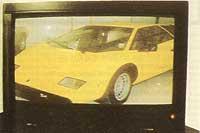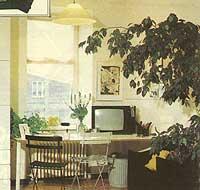Cinemascope on TV
The two side edges of the image are not seen when shooting cinemascope movies on television so far, as the screen is too square. The current screens have a ratio of 4/3 (width by height), but they have also begun to sell in 16/9 format.


Within five years, all television programs will be made in high definition (1250 lines) and in 16/9 format, for which Philips and Thomson have prepared their products in Europe. The latter has already launched its first model Space System with a screen of 75,2x42,3 cm.
In this television you can see the complete image of the films in cinemascope, Panavision or Vistavision format, in the current systems PAL, SECAM or NTSC (the latter system requires magnetoscope).
In France, for its part, programs in 16/9 format will be issued during these months in the D2-MAC Paquet system or in the normal definition of line 625. The Canal Plus, Sept and Antene 2 stations are committed to broadcasting some of their programs in this broad format. In addition, when programs start streaming in HD, the normal will be a wide and current 4/3 format only for older programs and movies.
On Thomson's Space System TV you can switch from 4/3 to 16/9 (and vice versa) when you want by means of a remote control and adapt the image to the original cinematic format using the zoom. For example, if it is 4/3 film, filling the entire 16/9 screen can lead to deformation of a little (almost invaluable) image. This format change on the D2-MAC system is automatic as command signals are issued to the antenna. Most French stations that broadcast on the D2-MAC system are cryptic (images and sounds at the same time with noise and need deco to be able to see it correctly), but the Space System television does not include a D2-MAC deco. The Visiopass decos of Canal + in Decsat and France Télécom, used by the subscriber public, decode D2-MAC.
But those who don't want to pay and want to see what the public network Sept broadcast satellite TDF-1 on D2-MAC, have another opportunity for Thomson. Together with the satellite receiver they can install a decoder and a satellite dish on the outside for an approximate cost of 100,000 pesetas.
In the coming years the HD-MAC decoding card will be proposed in order to catch the HD TV of 1,250 lines. However, currently the programs emitted in 625 lines can be seen in 1,250 lines, since inside the receiver lines are doubled to improve the stability and fineness of the images. The tube of this new television has a resolution of 1,000 pixels, which means a total resolution of 1,250,000 pixels. In view of the recent evolution of audiovisual products (magnetoscope, truck, compact disc, video CD, photo-CD, etc.) Thomson puts five Peritel connections to his television. This allows you to connect European TV with high definition HD-MAC, satellite demodulators, magnetoscopes and other audio or video devices.


Space System
the television model has a numerical treatment of the signals, being able to insert the image. The PIP system (picture in picture) allows you to see not only the program being viewed, but also those being broadcast on other strings simultaneously on the screen. In addition, it has all the signage and advances of classic television.
As for the sound, it has a stereo amplifier of five speakers. It has two speakers for high sounds, two for medium and one for bass. In programs that are broadcast in numerical sound (French and German broadcasters broadcast on D2-MAC), sound quality is the same as in compact discs. This quality can be used completely connected to a Hifi equipment. It has two outputs and one front to connect the stereo helmet.
Thomson is committed to the manufacture of TVs with 16/9 ratio screens and expects to sell devices 73 cm wide by 2.50 meters diagonal by retroprojector. They say the stockings to be sold in 2000 will be proportional to 16/9. Now in their German Black Forest factory in Villingen they produce 1,000 televisions of this type every month. The 16/9 pipeline is manufactured by Videocolor from Italy, with an age of 150,000 years.
Space System
devices have recently started to be sold in France and are spreading to Germany and Italy. They are expected to hit the US market next year. Therefore, HD television is coming out of the laboratory and reaching the general public.





